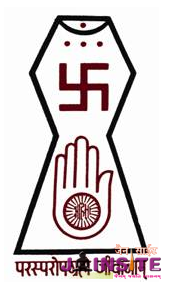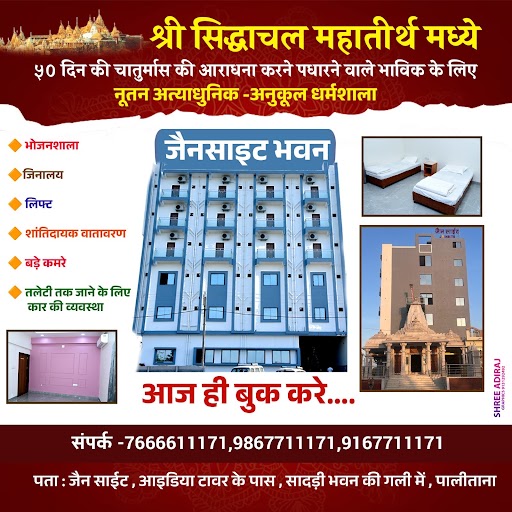Chapter 09 – Jain Symbols
Main Symbol
This Jain Symbol is an arrangement of various symbols, each having a significant meaning. This symbol was adopted by all sects of Jainism while commemorating the 2500th anniversary of the nirvana of Lord Mahävir.
The outline of the symbol represents the shape of the universe (Loka). The lower part of the symbol represents the seven hells (Näraki). The middle part of the universe contains the Earth and the planets (Manushya-Loka). The upper part contains the heavenly abodes (Deva-Loka) of all the celestial beings and the abode of the Siddhas (Siddhashilä). Jains believe that this universe was neither created by anyone, nor can it be destroyed by anyone. It is Static and will remain at the same location in the vast empty space of the entire existence.
The raised hand means stop. The word in the center of the wheel is “Ahinsä”. Ahinsä means non- violence. Together they remind us to stop for a minute and think twice before doing anything. This gives us a chance to scrutinize our activities to be sure that they will not hurt anyone by our thoughts, words or actions. We should also not to ask or encourage others to take part in any harmful activity. The wheel inside the hand indicates that if we are not careful and carry on violent activities, then just as the wheel goes round and round, we will go round and round through the cycles of birth and death.
The four arms of the Swastika remind us that during the cycles of birth and death we may be born into any one of the four realms: heavenly beings, human beings, animal beings, (including birds, bugs, and plants) and hellish beings. Our aim should be liberation and not rebirth. To show how we can do this, the swastika also reminds us that we should become pillars of the four folds Jain Sangha. Only then can we achieve liberation. The four pillars of the Jain Sangha are Sädhus, Sädhvis, Shrävaks, and Shrävikäs. This means that first we should strive to be a true Shrävaks or Shrävikäs, and when we overcome our social attachments, we should renounce worldly life and follow the path of a Sädhu or Sädhvi to be liberated. The four arms are also representative of Däna (charity), Sheel (virtue), Tapa (austerities), and Bhäv (noble thoughts)
The three dots above the swastika represent the three jewels of Jainism: Samyag Darshan (Right Faith), Samyag Jnän (Right Knowledge), and Samyag Chäritra (Right Conduct). We should have all three: with right faith, right knowledge, and right conduct together we can achieve liberation. Right knowledge means having the knowledge that soul and body are separate and that the soul, not the body attains salvation. Right faith means one must have faith in the true knowledge of soul and matter and its relationship as defined in Jain Karma Philosophy. Right conduct means that our actions should be devoid of attachment and hatred.
At the very top part of the Jain symbol is a small crescent. It is known as the Siddhashilä. This crescent represents the abode of the Siddhas. It is the final resting place of liberated souls. The dot represents a Siddha. In order to achieve this stage, a soul must destroy all attached karmas. Every living being should strive for this state of Salvation or Liberation.
Symbol Adopted by JAINA:
Federation of Jain Associations in North America (JAINA) has adopted this symbol. The Swastika from main symbol has been replaced by the Om (Aum) symbol. In western world, Swastika is not viewed as a pious symbol. Let us see what Om represents:
The Sanskrit word Om (Aum) is made up of five sounds and letters; a, a, aa, u, and m:
- The first letter “a” represents Arihanta (human being who has realized the true nature of reality and has conquered passions)
- The second “a” represents A-shariri (A-shariri means a soul without physical body, liberated soul or Siddha or perfected being)
- The third letters “aa” represents Acharya (Ascetic who is head of the congregation)
- The fourth letter “u” represents Upadhyay (Ascetic teacher)
- The fifth letter “m” represents Muni (Sadhu or Sadhvis who practice Jain principles).
Hence, the Om represents a salutation to the five revered personalities in the Jain religion. Om is a short form of the Namokär Mantra.
The text underneath the symbol, “Parasparopagraho Jivänäm” translates as “Living beings (souls) render services to one another”.



